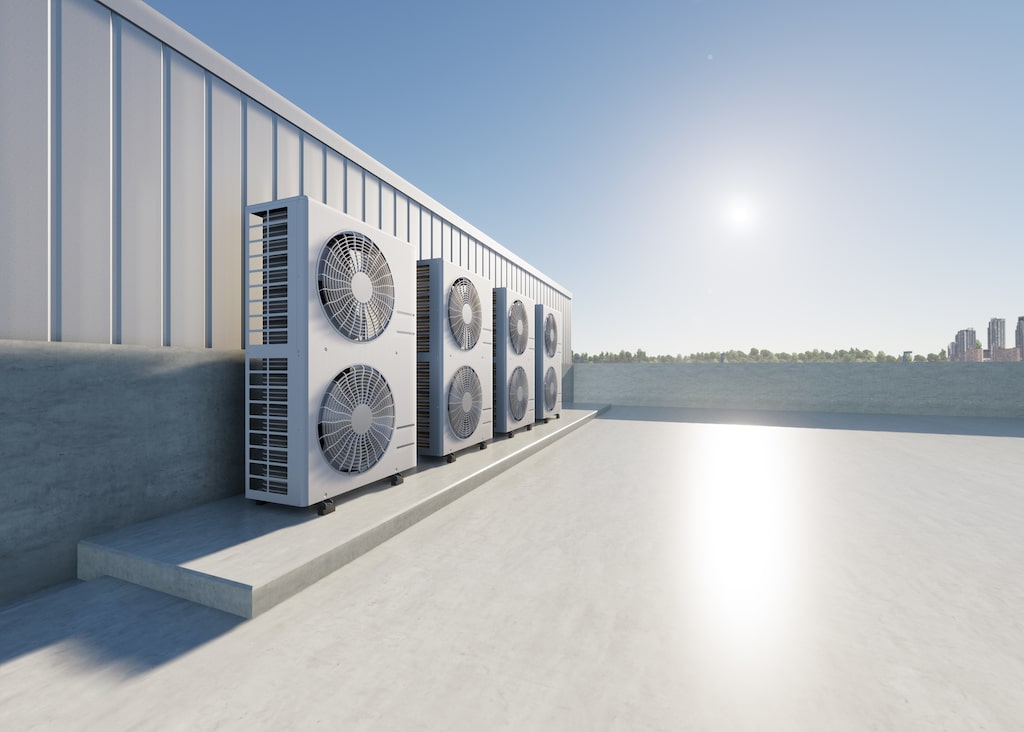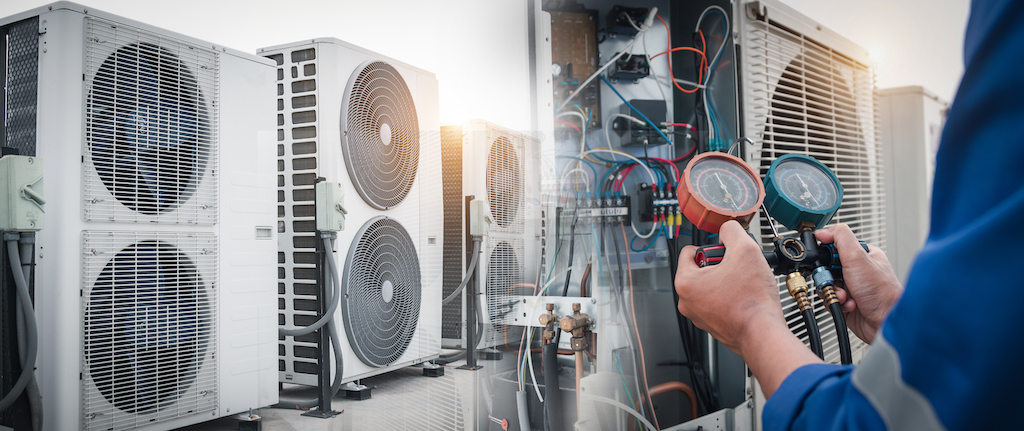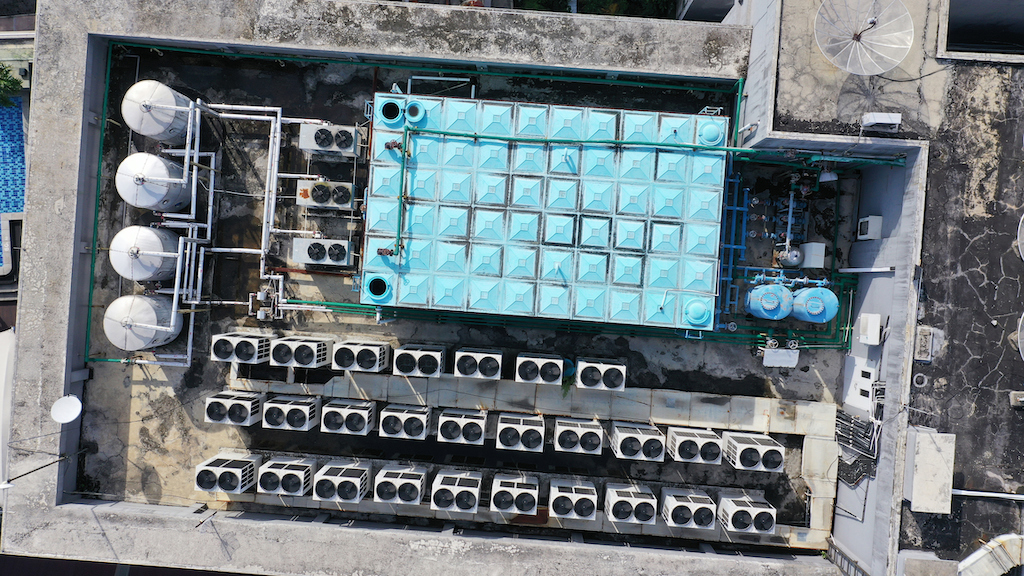
Unlock Comfort: Mastering Commercial AC Installation
You’ve probably wondered how to keep your business space comfortable and efficient, especially during those sweltering summer months.
Commercial AC installation is not just about beating the heat; it’s about creating an environment where your employees and customers feel comfortable, and your operations run smoothly.
In this article, we’ll dive deep into the world of commercial AC installation. From understanding the basics to exploring advanced tips for ensuring your system runs efficiently, we’ve got you covered.
You’ll learn about the importance of choosing the right system, the installation process, and how to maintain your AC for years of trouble-free operation.
Whether you’re installing a new system or upgrading an old one, this guide will help you make informed decisions.

Photo By Nonthanat Puengtrakun at iStock
What is Commercial AC Installation?
Commercial AC installation is a comprehensive process that involves the strategic planning, selection, and setting up of air conditioning systems within commercial buildings, including offices, retail spaces, restaurants, and more, aiming to create a comfortable and conducive environment for both occupants and visitors.
This process is not just about installing a cooling unit; it encompasses a thorough assessment of the building’s layout, understanding the unique cooling requirements of different spaces, and choosing the most efficient and effective system that aligns with the building’s needs.
The installation process begins with a detailed evaluation of the commercial space to determine the appropriate type and size of the AC system. This involves calculating the cooling load, considering factors such as the building’s size, the number of windows, the amount of sunlight exposure, and the usual occupancy level.
The goal is to ensure that the selected system can efficiently manage the space’s cooling demands without overburdening the system, leading to unnecessary energy consumption and costs.
Also read: Effortless Comfort: Air Conditioning for Homes with Boilers Service
A Detailed Explanation of Commercial AC Installation
Commercial AC installation is a critical task that requires careful planning, selection, and execution to ensure optimal performance and efficiency.
Understanding Your Needs
Evaluating Building Size and Structure
When planning for commercial AC installation, the first step is to thoroughly evaluate the size and structure of your building. This is crucial because the capacity and type of AC system you need directly depend on the square footage you need to cool.
Larger spaces require systems with higher capacities to ensure efficient cooling throughout the entire area. Additionally, the structure of your building, including ceiling heights, window sizes, and insulation quality, plays a significant role in determining the cooling load.
A building with high ceilings and large windows, for example, may lose cool air more quickly than a more compact space, necessitating a more robust system.
Understanding these aspects helps in selecting an AC system that matches your commercial space’s specific requirements, ensuring that every corner of your establishment remains comfortable for occupants and visitors alike.
Assessing Occupant Load
The number of people who typically use the space is another critical factor to consider before a commercial AC installation.
More occupants mean more body heat, which can significantly affect the indoor temperature. High-traffic areas like retail spaces, restaurants, or offices with a large workforce require AC systems that can handle the additional load.
This assessment helps in choosing a system that not only cools efficiently but also manages air quality, ensuring a comfortable environment for everyone inside.
It’s not just about maintaining a pleasant temperature; it’s also about ensuring that the air circulation and ventilation are adequate to keep the air fresh and free from pollutants, which is especially important in crowded spaces.
Budgeting for Your System
Budgeting is a critical aspect of planning for commercial AC installation.
The cost of installing a new AC system can vary widely depending on the type of system you choose, the complexity of the installation, and the specific needs of your commercial space.
It’s important to set a realistic budget that covers not only the initial purchase and installation costs but also the long-term operating and maintenance expenses. Energy-efficient systems, for example, may have a higher upfront cost but can lead to significant savings on energy bills over time.
Consulting with a professional HVAC contractor can provide you with a clearer understanding of the costs involved and help you make an informed decision that balances your cooling needs with your financial constraints.
Proper budgeting ensures that you invest in a system that provides the best value for your money, offering efficient cooling without breaking the bank.
Considering Future Needs
While assessing your current needs is essential, it’s also wise to consider the future when planning a commercial AC installation.
Your business might grow, leading to increased occupancy or the need for additional space. Choosing a scalable AC system that can accommodate future expansion without requiring a complete overhaul can save you time and money in the long run.
Additionally, technological advancements are continuously improving AC systems’ efficiency and functionality.
Opting for a system that can be easily updated or integrated with new technologies ensures that your commercial space remains comfortable and energy-efficient for years to come.
Planning with the future in mind allows you to adapt to changes in your business or technological advancements without needing a complete system replacement.
By taking the time to understand your commercial space’s specific needs, you can ensure that your commercial AC installation is a success.
Evaluating your building’s size and structure, assessing occupant load, budgeting carefully, and considering future needs are all crucial steps in selecting the right AC system.
This thoughtful approach ensures that your investment provides a comfortable, efficient, and adaptable cooling solution for your commercial space.
How to Choose the Right AC System
Understanding Split Systems
When it comes to commercial AC installation, split systems are a popular choice for many businesses. These systems consist of two main components: an outdoor unit that houses the compressor and condenser, and an indoor unit that contains the air handler.
This separation allows for a quieter operation indoors and more flexible installation options. Split systems are particularly advantageous for commercial spaces that have limited space for ductwork or need individual room control.
They offer efficient cooling and can be scaled by adding more indoor units connected to a single outdoor unit, making them a versatile option for businesses that anticipate growth or have varying cooling needs across different areas.
The ability to control temperatures in specific zones can also lead to energy savings, as you only cool the spaces in use. When considering a split system for your commercial AC installation, it’s important to assess the layout of your space and determine the best placement for both the indoor and outdoor units to maximize efficiency and comfort.
Exploring Central Air Conditioning
Central air conditioning systems are ideal for larger commercial spaces that require a uniform cooling solution. These systems use a network of ducts to distribute cool air throughout the entire building, ensuring a consistent temperature in all areas.
Central AC systems are highly efficient for cooling large spaces and are often easier to maintain than multiple individual units.
When selecting a central air conditioning system for your commercial AC installation, consider the system’s Seasonal Energy Efficiency Ratio (SEER) rating. A higher SEER rating indicates better energy efficiency, which can significantly reduce operating costs over time.
Additionally, central systems can be integrated with air filtration and humidity control solutions, improving indoor air quality and creating a more comfortable environment for occupants.
However, the installation of central air conditioning requires careful planning to ensure the ductwork is properly designed and installed to avoid energy loss and ensure efficient operation.
Considering Ductless Mini-Splits
Ductless mini-split systems offer a flexible and efficient solution for commercial AC installation, especially in spaces where ductwork is impractical or impossible to install. These systems consist of an outdoor compressor unit connected to one or more indoor air handling units via small conduits.
Each indoor unit can be controlled independently, allowing for precise temperature control in different areas or rooms. This not only enhances comfort but also improves energy efficiency by cooling only the spaces that are in use.
Ductless mini-splits are particularly suited for commercial spaces with unique architectural features, additions, or where the installation of ductwork would be too invasive or costly.
They are also an excellent choice for businesses looking for an energy-efficient upgrade or addition to their existing cooling system. When selecting a ductless mini-split system, consider the number of zones you need to cool, the total cooling capacity required, and the system’s SEER rating to ensure you choose the most efficient and effective solution for your space.
Making the Right Choice
Selecting the right AC system for your commercial space involves weighing the advantages and limitations of split systems, central air conditioning, and ductless mini-splits against your specific needs.
Factors such as the size and layout of your space, the existing infrastructure, energy efficiency goals, and budget constraints all play a crucial role in this decision.
Consulting with a professional HVAC contractor who has experience in commercial AC installation can provide valuable insights and recommendations tailored to your business. They can assess your space, understand your cooling needs, and help you choose the system that offers the best balance of comfort, efficiency, and cost-effectiveness.
Making the right choice ensures that your commercial space remains comfortable for employees and customers alike, while also managing energy costs effectively.
The Installation Process
Planning and Preparation
The first step in the commercial AC installation process is meticulous planning and preparation. This phase involves a detailed assessment of the commercial space to determine the optimal placement for the AC units, both indoor and outdoor.
The goal is to identify locations that will ensure efficient airflow and cooling while minimizing energy loss.
Proper planning also includes evaluating the existing electrical infrastructure to ensure it can support the new AC system without requiring extensive upgrades.
This stage is crucial for avoiding potential issues and delays during the installation process. It involves coordinating with building managers, architects, and other stakeholders to ensure the installation plan aligns with any building codes and regulations.
By thoroughly preparing before any physical work begins, professionals can ensure a smoother installation process, reducing the risk of unexpected challenges that could affect the system’s efficiency and performance.
Secure Mounting and Installation
Secure mounting is a critical aspect of the commercial AC installation process. It ensures that both the indoor and outdoor units of the AC system are installed safely and securely, reducing the risk of damage or malfunction.
For outdoor units, this means choosing a location that is not only accessible for maintenance but also protected from extreme weather conditions and potential vandalism.
The mounting surface must be stable and level to prevent vibration, which can lead to noise issues and reduce the lifespan of the unit.
Indoor units require careful consideration of airflow and aesthetics, ensuring they are placed in locations that maximize cooling efficiency without disrupting the interior design. Professional installers use specialized tools and techniques to secure the units, paying close attention to manufacturer guidelines and building codes.
This attention to detail during the mounting process is essential for the longevity and efficiency of the AC system.
Ductwork and Ventilation
In cases where a new ducted system is being installed, the installation process involves significant work on ductwork and ventilation. This is a complex task that requires precise design and installation to ensure efficient air distribution and optimal indoor air quality.
The ductwork must be properly sealed and insulated to prevent air leaks and energy loss.
The layout of the ducts needs to be planned to ensure that cool air is evenly distributed throughout the commercial space, avoiding hot spots or areas with insufficient airflow.
Ventilation is also a key consideration, as it helps to remove stale air, control humidity, and reduce the concentration of airborne contaminants.
Professional HVAC contractors use advanced tools and techniques to design and install ductwork and ventilation systems that are tailored to the specific needs of the commercial space, ensuring that the AC system operates at peak efficiency.
System Testing and Commissioning
After the AC system has been installed, the next critical step is system testing and commissioning. This phase involves thoroughly testing the system to ensure it operates correctly and efficiently.
Technicians will run the system through various operational modes, checking for proper airflow, temperature control, and responsiveness to controls. This is also the time to identify and rectify any issues, such as leaks in the ductwork or problems with the electrical connections.
Commissioning the system includes verifying that all components are correctly installed and functioning as intended, ensuring that the system meets the design specifications and the needs of the commercial space.
This final step is crucial for guaranteeing the performance and efficiency of the AC system, providing peace of mind that the installation has been completed successfully and the system is ready for use.
Professional installation is the cornerstone of a successful commercial AC installation, encompassing careful planning, secure mounting, meticulous attention to ductwork and ventilation, and thorough system testing and commissioning.
Each step is vital to ensure that the AC system operates efficiently, providing reliable cooling and comfort for commercial spaces.

Photo By Kunakorn Rassadornyindee at iStock
Maintenance and Upkeep of Your AC Systems
The Importance of Routine Cleaning
Routine cleaning is a cornerstone of effective maintenance for any commercial AC installation. Over time, dust, dirt, and debris can accumulate in various parts of the AC system, including the filters, coils, and ductwork.
This accumulation not only reduces the system’s efficiency by obstructing airflow but can also lead to poorer indoor air quality, which can affect the health and comfort of occupants.
Regular cleaning ensures that all components of the AC system are free from obstructions, allowing for optimal performance. This involves cleaning or replacing air filters, cleaning the evaporator and condenser coils, and ensuring that the ductwork is clear of dust and debris.
By maintaining a clean AC system, businesses can enjoy lower energy bills, a reduced need for repairs, and a longer lifespan for their AC system, making routine cleaning an investment in the system’s future performance and reliability.
The Role of Filter Changes in AC Maintenance
Filter changes are a critical aspect of maintenance for commercial AC installations. Air filters play a crucial role in trapping dust, pollen, and other airborne particles, preventing them from circulating through the indoor environment.
However, over time, these filters can become clogged, restricting airflow and forcing the AC system to work harder to maintain the desired temperature. This not only increases energy consumption but can also lead to wear and tear on the system, potentially resulting in costly repairs or premature failure.
Regularly changing the air filters, as recommended by the manufacturer, ensures that the AC system can operate efficiently, providing clean, cool air while also extending the system’s lifespan.
This simple maintenance task can have a significant impact on the performance and efficiency of the AC system, making it a priority for businesses looking to maintain a comfortable and healthy indoor environment.
Professional Inspections and Their Benefits
Professional inspections are an essential component of a comprehensive maintenance plan for commercial AC installations. These inspections, conducted by experienced HVAC technicians, involve a thorough examination of the entire AC system to identify any potential issues before they become major problems.
Technicians will check for signs of wear and tear, test system components for proper function, and ensure that the system is operating efficiently.
They can also identify any adjustments or repairs that may be needed to prevent breakdowns during peak usage times.
Regular professional inspections can catch issues early, saving businesses from unexpected downtime and costly emergency repairs.
Additionally, these inspections can provide peace of mind, knowing that the AC system is in good condition and ready to provide reliable cooling when needed. Investing in professional inspections is a proactive step towards ensuring the long-term health and efficiency of a commercial AC system.
Creating a Maintenance Schedule
Creating a maintenance schedule is vital to ensuring the longevity and efficiency of a commercial AC installation.
A well-planned maintenance schedule outlines specific tasks that need to be performed regularly, such as routine cleaning, filter changes, and professional inspections.
This schedule should be tailored to the specific needs of the AC system, taking into account the manufacturer’s recommendations, the system’s age, and the demands placed on it by the commercial space.
By adhering to a regular maintenance schedule, businesses can prevent minor issues from becoming major problems, ensure that the system operates at peak efficiency, and extend the lifespan of the AC system.
A maintenance schedule also helps in budgeting for maintenance costs, allowing businesses to plan for the expenses associated with keeping their AC system in top condition.
Establishing and following a maintenance schedule is a proactive approach to AC system care, ensuring that the system provides reliable cooling and comfort year-round.
Maintenance and upkeep are crucial for the longevity and efficiency of commercial AC installations.
Through routine cleaning, regular filter changes, professional inspections, and adherence to a maintenance schedule, businesses can ensure that their AC systems run smoothly, providing comfortable and healthy indoor environments for occupants.
These maintenance tasks not only prevent costly repairs and downtime but also contribute to lower energy bills and a longer lifespan for the AC system.
Energy Efficiency and Sustainability
Choosing Energy-Efficient Models
In the realm of commercial AC installation, selecting energy-efficient models is a critical decision that can have long-lasting impacts on both operational costs and environmental sustainability.
Energy-efficient air conditioning systems are designed to use less electricity to produce the same amount of cooling as their less efficient counterparts. This efficiency is often measured by the Seasonal Energy Efficiency Ratio (SEER), where a higher SEER rating indicates a more efficient air conditioner.
By opting for models with high SEER ratings, businesses can significantly reduce their energy consumption, leading to lower utility bills.
Additionally, energy-efficient AC systems often come with advanced features like programmable thermostats and variable speed motors that further enhance their efficiency and adaptability to varying cooling needs.
Investing in energy-efficient commercial AC systems not only helps in cutting operational costs but also aligns with broader environmental sustainability goals by reducing the carbon footprint associated with cooling commercial spaces.
The Role of Eco-Friendly Refrigerants
Eco-friendly refrigerants play a pivotal role in enhancing the sustainability of commercial AC installations. Traditional refrigerants used in air conditioning systems have been known to contribute to global warming and ozone depletion.
In response, the HVAC industry has been moving towards refrigerants with lower Global Warming Potential (GWP) and no Ozone Depletion Potential (ODP).
These eco-friendly refrigerants, such as R-32, R-410A, and R-134a, offer a more sustainable alternative to their predecessors, helping to minimize the environmental impact of commercial cooling systems.
By choosing commercial AC systems that utilize eco-friendly refrigerants, businesses can significantly reduce their environmental footprint. This not only contributes to global environmental conservation efforts but also positions the business as a responsible and eco-conscious entity in the eyes of consumers and stakeholders.
The transition to eco-friendly refrigerants is a key component of making commercial AC installations more sustainable and is an important consideration for businesses looking to modernize their cooling systems.
Implementing Smart Thermostats for Enhanced Efficiency
Smart thermostats represent a technological advancement that can significantly enhance the energy efficiency of commercial AC installations. These devices allow for precise control over the cooling system, enabling businesses to adjust temperatures based on occupancy patterns and preferences.
With features like Wi-Fi connectivity, remote access, and learning capabilities, smart thermostats can optimize cooling schedules, reduce energy waste, and provide insights into energy usage patterns.
By adapting to the specific needs of the commercial space and making adjustments in real-time, smart thermostats can significantly reduce unnecessary cooling, leading to substantial energy savings.
Furthermore, the ability to monitor and control the AC system remotely offers convenience and flexibility, ensuring that the commercial space remains comfortable without overburdening the system.
Incorporating smart thermostats into commercial AC installations is a forward-thinking approach to energy management, offering both immediate and long-term benefits in terms of efficiency, cost savings, and environmental sustainability.
Sustainability Practices in AC System Design and Installation
Sustainability practices in the design and installation of commercial AC systems are essential for achieving long-term energy efficiency and environmental stewardship. This encompasses selecting energy-efficient equipment, utilizing eco-friendly refrigerants, and incorporating sustainable design principles that enhance the overall efficiency of the cooling system.
For instance, integrating the AC system with other building management systems can optimize performance and reduce energy consumption.
Additionally, considering the building’s orientation, insulation, and natural ventilation can minimize the cooling load, allowing the AC system to operate more efficiently.
Employing sustainable practices in commercial AC installation not only contributes to reducing operational costs and environmental impact but also aligns with growing regulatory requirements and consumer expectations for green building standards.
By prioritizing sustainability from the outset, businesses can ensure that their cooling systems are not only efficient and effective but also contribute to broader environmental and social goals.
Energy efficiency and sustainability are crucial considerations in commercial AC installation, encompassing the selection of energy-efficient models, the use of eco-friendly refrigerants, the implementation of smart thermostats, and the incorporation of sustainable design and installation practices.
Together, these elements contribute to creating commercial spaces that are not only comfortable and efficient but also environmentally responsible and aligned with future sustainability trends.

Photo By Amed-in-bali at iStock
How to Evaluate Your Commercial Space
Assess Square Footage and Layout
When considering commercial AC installation, the first step is to assess the square footage and layout of your commercial space.
The size of the area to be cooled is a primary factor in determining the capacity of the AC system needed. Larger spaces will require systems with higher BTU (British Thermal Unit) ratings to efficiently cool the entire area.
Additionally, the layout of the space, including open areas, partitioned offices, or multiple floors, can affect the type of AC system that will best suit your needs.
A professional HVAC contractor can help map out your space to suggest the most efficient cooling strategy, whether it’s a centralized system for open areas or a zoned system for spaces with varying cooling needs.
Consider Ceiling Height and Insulation Quality
Ceiling height and insulation quality are critical factors that can significantly impact the efficiency of your commercial AC installation.
Higher ceilings mean more volume to cool, which can require a more powerful AC system. Insulation quality affects how well your space retains the cooled air, with poor insulation leading to higher energy costs as the system works harder to maintain the desired temperature.
Evaluating these aspects of your commercial space can help determine the most energy-efficient AC system.
Upgrading insulation or choosing systems with variable speed compressors can mitigate these challenges, ensuring your space remains comfortable without excessive energy use.
Analyze Sun Exposure and Windows
Sun exposure and the number and size of windows in your commercial space can also influence your AC installation.
Rooms with significant sun exposure or large windows can become much hotter than other areas, requiring additional cooling capacity to maintain comfort.
Considering factors such as the direction of windows (south-facing windows receive more sunlight) and the type of window treatments can help in planning the AC system.
Using solar shades or thermal curtains can reduce cooling needs, while a professional evaluation can suggest whether additional units or specific types of AC systems are necessary to counteract the heat gain from sun exposure.
The Importance of a Professional Evaluation
A professional evaluation is indispensable in the process of commercial AC installation.
HVAC professionals bring expertise in assessing all the factors mentioned—square footage, ceiling height, insulation quality, and sun exposure—and can recommend the best type and size of AC system for your space.
They use specialized tools and calculations to ensure that the proposed system meets your cooling needs efficiently.
Moreover, a professional can identify potential challenges and suggest improvements or modifications to your space that could enhance the system’s efficiency, such as upgrading insulation or installing energy-efficient windows.
This comprehensive approach ensures that you invest in an AC system that is perfectly tailored to your commercial space, providing optimal comfort and efficiency.
How to Select the Right HVAC Contractor
Verifying Licensing and Certification
When embarking on a commercial AC installation project, the first step in choosing the right HVAC contractor is to verify their licensing and certification.
A licensed contractor has met the state or local jurisdiction’s requirements to perform HVAC work, ensuring they have the necessary knowledge and adherence to building codes and regulations.
Certification, especially from recognized industry organizations like NATE (North American Technician Excellence), further validates the contractor’s expertise in HVAC systems.
This verification process is crucial as it provides a foundation of trust and professionalism, ensuring that the contractor is legally and technically equipped to handle the complexities of commercial AC installations.
Assessing Insurance Coverage
Insurance coverage is another critical factor to consider when selecting an HVAC contractor for your commercial AC installation.
A reputable contractor should have liability insurance and workers’ compensation to protect you and your property from potential accidents or damage during the installation process.
Insurance coverage not only signifies the contractor’s professionalism but also provides peace of mind that you won’t be held financially responsible for any unforeseen incidents.
Asking for proof of insurance and ensuring it’s up to date is a prudent step in the selection process.
Evaluating Experience and Specialization
Experience and specialization in commercial AC installations are vital attributes of a suitable HVAC contractor.
An experienced contractor will have a track record of successful installations and will be familiar with the unique challenges and requirements of commercial systems. Specialization in commercial HVAC systems is equally important, as these systems are often more complex than residential ones.
A contractor who specializes in commercial HVAC will have a deeper understanding of the specific needs of businesses, including the importance of energy efficiency, system reliability, and tailored cooling solutions.
Evaluating a contractor’s experience and specialization involves reviewing their portfolio, asking about previous projects similar to yours, and assessing their approach to addressing your specific needs.
Considering Customer Reviews and References
Customer reviews and references are invaluable resources when selecting an HVAC contractor for commercial AC installation.
Reviews on third-party websites, testimonials on the contractor’s website, and direct references from past clients can provide insights into the contractor’s reliability, quality of work, and customer service.
Positive feedback from other businesses, especially those with similar AC installation needs, can be a strong indicator of the contractor’s ability to deliver satisfactory results. Conversely, a pattern of negative reviews should raise red flags and prompt further investigation.
Asking the Right Questions
Asking potential HVAC contractors the right questions is crucial to making an informed decision. Inquire about their approach to commercial AC installation, including how they assess needs, select systems, and handle challenges.
Questions about warranty, post-installation support, and maintenance services can also reveal the contractor’s commitment to customer satisfaction and long-term service.
Additionally, asking about their timeline for completion, communication process, and how they manage disruptions can help set expectations for the project.
Identifying Red Flags
Identifying red flags is essential to avoid selecting the wrong HVAC contractor. Be wary of contractors who provide vague or overly simplistic answers, avoid providing detailed quotes, or pressure you into making a quick decision.
Lack of proper licensing, insurance, or reluctance to provide references should also be considered major red flags.
A reputable contractor will be transparent, professional, and willing to address all your concerns to ensure a successful commercial AC installation.
Selecting the right HVAC contractor is a critical step in ensuring the success of your commercial AC installation project.
By focusing on licensing, insurance, experience, customer reviews, asking the right questions, and being aware of red flags, you can find a contractor who meets your needs and ensures a smooth, efficient installation process.
One Hour Air Conditioning & Heating of Fort Worth: Your Go-to AC Installation Experts
For businesses in Fort Worth, TX, and surrounding areas, One Hour Air Conditioning & Heating of Fort Worth stands out as a reliable partner for commercial AC installation.
With a team of experienced professionals, they offer comprehensive installation services tailored to meet your specific needs. Their commitment to quality and customer satisfaction ensures that your commercial space remains comfortable and energy-efficient.
Check out their reviews and ratings here and consider them for your next AC installation project.
For services in Fort Worth, TX, Azle, TX, Euless, TX, North Richland Hills, TX, Arlington, TX, Southlake, TX, Keller, TX, Grapevine, TX, and more, call 817-283-6911.

Photo By Anton Lutsenko at iStock
FAQs
1.What factors should I consider before a commercial AC installation?
Before a commercial AC installation, consider your building’s size, layout, occupancy levels, and specific cooling needs. Assessing these factors ensures the selected system meets your requirements efficiently.
2.How often should commercial AC systems be serviced?
Commercial AC systems should be serviced at least once a year. Regular maintenance ensures optimal performance, energy efficiency, and can prevent costly repairs.
3.Can I upgrade my existing commercial AC system to be more energy-efficient?
Yes, upgrading your existing AC system with energy-efficient models or incorporating technologies like smart thermostats can significantly improve energy efficiency and reduce operating costs.
4.What is the importance of hiring a reputable HVAC contractor for commercial AC installation?
Hiring a reputable HVAC contractor ensures that your commercial AC installation is performed correctly, adhering to industry standards and regulations, which is crucial for the system’s efficiency and longevity.
5.How can smart thermostats benefit my commercial AC installation?
Smart thermostats offer precise control over your AC system, allowing for customized cooling schedules, reduced energy consumption, and enhanced comfort levels in your commercial space.
Remember, for the most accurate and up-to-date information, including hyperlinks and specific details about services like One Hour Air Conditioning & Heating of Fort Worth, it’s best to directly consult the relevant websites or contact the service providers.
Read our previous blog topic.
Check out this tip!
Dustin Hufsey


